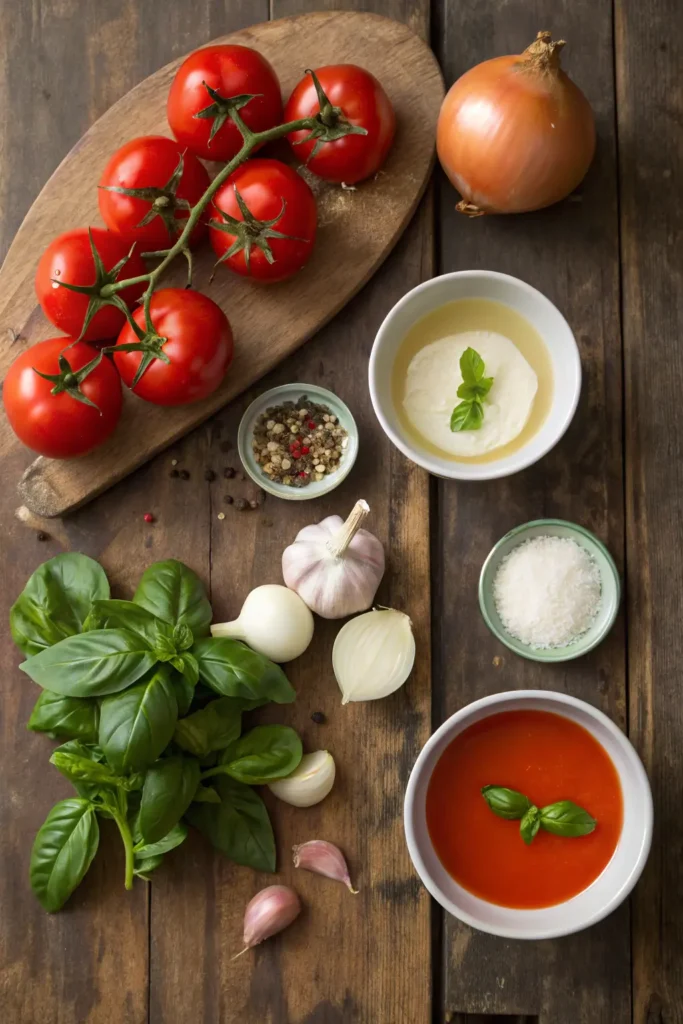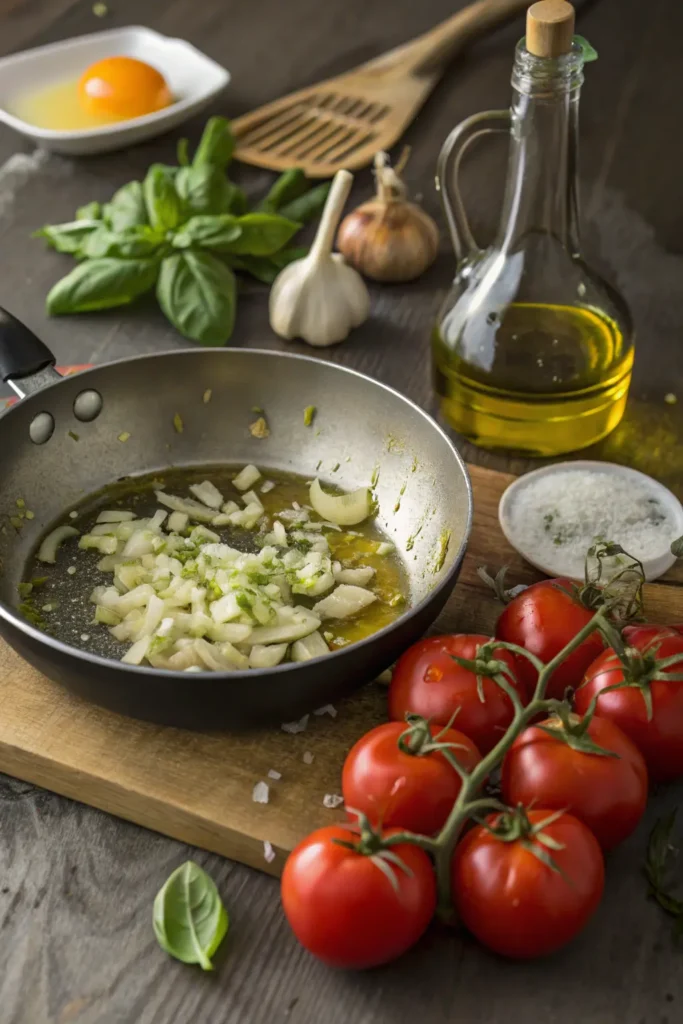Warm, creamy, and bursting with garden-fresh flavor—Tomato Basil Bisque is more than just soup; it’s a bowlful of comfort. Whether you’re looking for a cozy lunch, a starter that wows, or a base for hearty add-ons, this dish delivers every time. In this guide, we’re diving deep into everything you need to know about Tomato Basil Bisque, from its humble beginnings to gourmet twists, from must-have ingredients to pairing suggestions that elevate the experience.
You’ll learn how to perfect the creamy texture, choose the right type of tomatoes and basil, avoid common cooking blunders, and even whip up vegan or spicy variations. We’ll also cover storage tips, nutritional value, and delicious serving ideas. Oh, and don’t skip the FAQ section—we’ve got the answers to the internet’s most-asked tomato soup questions.
Let’s get that soup simmering.
Discover with us this easy and delicious recipe: Burger King Chicken Burger Sauce
Introduction to Tomato Basil Bisque
What is Tomato Basil Bisque?
Ah, Tomato Basil Bisque—a silky-smooth cousin of the traditional tomato soup, but with an indulgent, creamy flair. While some people confuse it with tomato soup, a true bisque leans heavier on richness. It usually includes cream or a plant-based alternative and is blended to perfection for a velvety texture.
This classic dish blends ripe tomatoes and fresh basil into a warm, luxurious treat. Often topped with a drizzle of cream or a basil leaf swirl, it’s the kind of comfort food that feels just as at home in a five-star restaurant as it does in your own kitchen.
Defining the Classic Soup with a Gourmet Twist
Unlike your average soup, a bisque is thick, smooth, and full-bodied. The addition of heavy cream or cashew milk, combined with aromatics like garlic and onions, transforms this tomato-based dish into something truly special.
How It Differs from Tomato Soup
Here’s the scoop—while tomato soup is often light and brothy, Tomato Basil Bisque is pure richness. The soup’s texture is more refined, the flavors are deeper, and the cream element brings it all together. Many bisques also use roasted tomatoes for an extra kick of flavor. It’s the elevated version of your childhood favorite.
History and Origins of Tomato Basil Bisque
From French Cuisine to American Comfort Food
The word bisque originates from French cuisine, typically used for creamy seafood soups. But culinary evolution brought us the plant-based version we know today. By the late 20th century, American chefs had adapted the bisque method to suit vegetables—especially tomatoes—creating this now-popular soup.
It was originally considered a gourmet item, often served in high-end restaurants. Over time, however, it found its way into home kitchens thanks to its simple ingredients and satisfying flavor.
Discover with us this easy and delicious recipe: recipesfreesh
The Evolution of Tomato-Based Soups
Tomato soup has a long and rich history, dating back to when tomatoes became a staple in European and American kitchens. Adding fresh basil and cream was a natural evolution, creating what we now savor as Tomato Basil Bisque. Today, you’ll find endless variations—vegan, spicy, roasted, and even keto-friendly.
Key Ingredients in a Perfect Tomato Basil Bisque

Essential Fresh Ingredients for Authentic Flavor
When it comes to crafting a truly delicious Tomato Basil Bisque, your ingredients can make or break the dish. Starting with fresh, high-quality produce ensures your bisque will be loaded with natural sweetness and aroma. It’s tempting to grab whatever’s in your pantry, but trust us—using the right components elevates your soup from basic to restaurant-worthy.
Tomatoes: Fresh, Roasted, or Canned?
Tomatoes are the heart of any creamy tomato soup, and your choice here matters. Fresh vine-ripened tomatoes bring a bright, clean taste, but if they’re out of season, don’t sweat it—canned San Marzano tomatoes are a fantastic alternative.
Want deeper flavor? Try roasting your tomatoes. Roasted tomatoes develop caramelized edges and smoky depth that add complexity to your Tomato Basil Bisque.
Basil: Sweet vs. Thai – Which is Better?
Basil brings that fresh, herbaceous punch. For a classic bisque, sweet basil is your go-to—it blends beautifully with the acidity of tomatoes and adds a subtle floral note. While Thai basil offers a more peppery, licorice-like flavor, it’s not typically used in traditional bisque recipes. However, if you’re feeling experimental, a mix of both can surprise your taste buds.
Supporting Ingredients That Add Creaminess and Depth
A rich bisque isn’t just about tomatoes and basil—it’s also about those background flavors that pull everything together. Think of these as your “flavor builders.”
Garlic, Onions, and Olive Oil
Garlic and onions form the aromatic base of any solid soup recipe. Sautéed in olive oil, they create the savory foundation that allows the tomatoes and basil to shine. Red onions add sweetness, while yellow ones offer a balanced, mellow note.
Stock vs. Water: What’s Best?
Vegetable stock wins hands down. It adds umami depth and richness without overpowering the delicate basil. Water works in a pinch, but it may leave your Tomato Basil Bisque tasting flat. Chicken broth is another solid choice for non-vegetarian versions.
Cream or Dairy-Free Alternatives
Here’s where your bisque takes on that iconic silky texture. But don’t worry—there are amazing options whether you’re a dairy lover or plant-based eater.
Using Coconut Milk or Cashew Cream
For a dairy-free twist, coconut milk or homemade cashew cream are fantastic choices. Coconut milk adds a slightly sweet, tropical vibe, while cashew cream keeps it neutral and extra velvety.
Vegan-Friendly Tomato Basil Bisque Variations
To keep it fully vegan, use olive oil instead of butter, a good vegetable broth, and your favorite plant-based cream. Add nutritional yeast for a hint of cheesiness without the dairy.
Step-by-Step Cooking Method for Tomato Basil Bisque

Preparation Before Cooking
Before you fire up the stove, take a little time to get organized. A bit of prep can streamline your cooking and lead to better results. After all, good mise en place (everything in its place) is every great cook’s secret weapon.
Chopping, Roasting, and Prepping Ingredients
Chop your onions, garlic, and basil leaves. If you’re using fresh tomatoes, core and halve them for roasting. Lay them on a baking sheet with a drizzle of olive oil, salt, and pepper. Roast at 400°F until they blister and brown slightly—this step adds rich, smoky depth.
Tools You’ll Need: Blender, Pot, Knife Set
At a minimum, you’ll need a large soup pot, a sharp chef’s knife, a wooden spoon, and either a stand blender or immersion blender. A ladle helps too. If you want restaurant-smooth soup, a high-speed blender is your best friend.
Cooking the Perfect Base
Now that everything’s chopped and ready, it’s time to build that flavor base. This stage sets the tone for your entire bisque.
Sautéing Aromatics
Start by heating olive oil in your pot. Toss in chopped onions and garlic, sautéing until translucent and fragrant. This step coaxes out their natural sweetness and infuses the oil with flavor. Don’t rush it—low and slow wins here.
Simmering Tomatoes and Herbs
Add your roasted (or canned) tomatoes to the pot, followed by stock or broth. Toss in some torn basil leaves, salt, pepper, and a pinch of sugar if your tomatoes are too tangy. Simmer the mixture for 20–30 minutes, letting all the flavors marry.
Blending and Final Touches
After simmering, your bisque will be ready for its transformation into creamy goodness. Whether you’re using a blender or immersion stick, do this step carefully—it’s hot!
How to Blend for the Silkiest Texture
Let the soup cool slightly before blending. Blend in batches, or directly in the pot if using an immersion blender, until smooth. If you want extra finesse, strain it through a fine mesh sieve for that ultra-luxurious texture.
Adding Cream and Adjusting Seasoning
Once blended, return the soup to the pot and stir in your cream of choice—be it heavy cream, coconut milk, or cashew cream. Heat gently and taste-test for salt, pepper, and acidity. A splash of balsamic vinegar or lemon juice can brighten up the whole pot.
Tomato Basil Bisque Recipe Variations You Must Try
If you’ve already mastered the basic Tomato Basil Bisque, why not shake things up? With a few easy tweaks, this classic comfort soup can transform into a bold, spicy, or plant-powered version of itself. Below are some of the most popular and creative twists you can make at home.
Spicy Tomato Basil Bisque
For those who like a little heat in their bowl, this variation is a must-try. You don’t need to overdo it—just a hint of spice adds excitement to the classic recipe.
Adding Chili Flakes or Jalapeños
Start small. Add crushed red pepper flakes while sautéing your onions and garlic. You can also toss in a deseeded jalapeño if you’re craving something spicier. Remember, the cream will mellow out the fire a bit, so balance is key. This version pairs perfectly with a cold glass of milk or creamy grilled cheese.
Vegan and Dairy-Free Tomato Basil Bisque
This variation is proof that you don’t need dairy to enjoy a rich, satisfying bisque. In fact, many folks prefer this lighter, cleaner version.
Plant-Based Creaminess
Swap heavy cream for coconut milk or unsweetened cashew cream. Use a vegetable broth base, and skip the butter—extra virgin olive oil works beautifully here. Finish with nutritional yeast for a subtle cheesy flavor. And yes, it’s still silky smooth!
Roasted Tomato Basil Bisque
Roasting your tomatoes isn’t just optional—it can completely transform the flavor profile. This version is deeper, slightly smoky, and full of umami.
Deepening Flavors through Roasting
Halve your tomatoes, drizzle them with olive oil, sprinkle with salt, and roast at 400°F until they blister and caramelize. When blended into the soup, these tomatoes lend a richness that’s hard to beat.
Tomato Basil Bisque with Grilled Cheese Toppers
Let’s face it—this soup and grilled cheese are soulmates. So why not combine them into one spoonful?
Pairing Classics for a Comfort Meal
Cut your grilled cheese into cubes or strips and float them on top of the soup like croutons. This not only makes the dish heartier but also adds a playful texture contrast.
Nutritional Profile and Health Benefits
Think creamy soups can’t be healthy? Think again. Tomato Basil Bisque might feel indulgent, but it also packs a nutritional punch—especially when made with whole, clean ingredients. Let’s break down what makes this dish both comforting and good for you.
Is Tomato Basil Bisque Healthy?
Absolutely—especially when made from scratch. Tomatoes are low in calories and rich in essential nutrients, while basil adds more than just flavor.
Calories, Carbs, and Nutrients Breakdown
A typical serving of homemade tomato bisque ranges between 150 to 250 calories, depending on the cream used. Most of those calories come from healthy fats and complex carbs. It’s also a solid source of vitamin C, vitamin A, and potassium.
Use coconut milk or cashew cream for lower saturated fat levels, or cut down the cream content if you’re watching calories.
The Benefits of Tomatoes and Basil
Tomatoes are loaded with lycopene, an antioxidant known for its anti-inflammatory and heart health benefits. Basil offers antibacterial properties and supports digestion. Together, they’re a one-two punch for your immune system.
Lycopene, Antioxidants, and Anti-Inflammatory Properties
Cooking tomatoes actually boosts lycopene levels. That means your bisque isn’t just delicious—it’s actively working to fight oxidative stress and inflammation in your body.
How to Make It Low-Fat or Keto-Friendly
Watching your macros? No problem. You can absolutely adapt Tomato Basil Bisque to meet your dietary needs.
Ingredient Swaps for Specific Diets
To keep it keto, use heavy cream and a low-carb tomato base—go for fresh tomatoes and skip sugar entirely. For a low-fat version, choose oat milk or blend cooked white beans into the base for added creaminess without the fat.
Pairing and Serving Suggestions for Tomato Basil Bisque

One of the best things about Tomato Basil Bisque is its incredible versatility. Whether you’re serving it as a main course, starter, or snack, it shines when paired with the right sides and garnishes. With just a few thoughtful additions, this simple soup can feel like a complete meal.
Best Side Dishes to Serve With It
You’ve probably guessed it—grilled cheese tops the list. But that’s just the beginning.
Grilled Cheese, Croutons, Garlic Bread
A classic grilled cheese sandwich is the perfect complement to creamy tomato soup. Use sharp cheddar or gooey mozzarella to get that perfect cheese pull. You can also toast up homemade garlic bread for dipping. Want something crunchy? Toss some buttery croutons on top of your bisque for added texture.
Other fun ideas include a side salad with vinaigrette, savory scones, or roasted vegetables. These balance the richness of the bisque and make your meal feel rounded.
How to Plate It for a Restaurant-Style Presentation
Even the simplest dishes can look elegant with the right touches. Presentation doesn’t have to be fancy—just clean and intentional.
Swirls of Cream, Basil Garnish, and Toasted Seeds
Try drizzling a swirl of cream on top before serving. Add a fresh basil leaf or chiffonade (thinly sliced basil) for a pop of green. For a little crunch, sprinkle toasted sunflower seeds or pumpkin seeds. Serve in a white bowl to make the colors pop and give it that modern bistro vibe.
Drink Pairings: Wine and Non-Alcoholic Options
Soup and drinks? Yes, please. While Tomato Basil Bisque may seem simple, it actually pairs beautifully with a variety of beverages.
What Complements the Creamy Tang?
A glass of light-bodied red wine like Pinot Noir or a crisp white like Sauvignon Blanc works wonderfully. If you’re going non-alcoholic, go for sparkling water with lemon, a chilled herbal tea, or a tomato-based veggie juice to keep the flavors cohesive.
Storage, Reheating, and Freezing Tips
Got leftovers? Great news—Tomato Basil Bisque stores well and often tastes even better the next day. However, proper storage and reheating techniques are key to maintaining flavor and texture.
How Long Does Tomato Basil Bisque Last in the Fridge?
In general, your bisque will keep for 3 to 4 days in the fridge when stored properly.
Safe Storage Guidelines
Let your bisque cool to room temperature before transferring it to an airtight container. Glass or BPA-free plastic containers work best. Label them with the date to keep track. It’s also smart to store portions separately for easy grab-and-heat meals.
Freezing Instructions
Want to make a big batch? Go ahead—Tomato Basil Bisque freezes like a dream if you do it right.
Preventing Texture Changes After Thawing
Here’s the trick: freeze the bisque before adding cream. Dairy can separate or become grainy when frozen, so it’s better to stir it in fresh after thawing. Store your bisque in freezer-safe containers or resealable bags laid flat to save space. It should keep well for up to 3 months.
Best Ways to Reheat Without Losing Flavor
Reheating seems simple, but there are ways to do it better—especially if you care about taste and texture.
Microwave vs. Stovetop Methods
The stovetop is your best bet. Just pour the bisque into a saucepan, heat it over medium, and stir often. If you’re using the microwave, heat it in short bursts and stir between rounds to avoid hot spots. And don’t forget to add the cream (if left out) only after it’s reheated.
Common Mistakes to Avoid When Making Tomato Basil Bisque
Even though Tomato Basil Bisque seems like a straightforward dish, a few common mistakes can take it from silky and savory to dull or unbalanced. If you’re aiming for that rich, creamy perfection, here’s what to steer clear of.
Overcooking the Basil
Fresh basil is delicate. While it adds that signature herbal note, tossing it into the pot too early can dull its flavor and even make it bitter.
Why Freshness Matters
Always add most of your basil at the end of cooking or even after blending. This keeps its aroma vibrant and avoids the “muddy” taste that overcooked herbs can bring. A little goes a long way, so don’t overdo it.
Using the Wrong Tomatoes
Not all tomatoes are created equal—especially when they’re the star of the show.
Acidic vs. Sweet Varieties
Using overly acidic tomatoes can throw off the balance of your bisque. Go for sweet vine-ripened tomatoes or San Marzano canned tomatoes. These provide a naturally sweet and rich flavor that blends beautifully with cream and basil.
Overblending or Underseasoning
Yes, texture matters—but so does taste.
Balancing Creaminess with Tang
While you want your bisque to be smooth, overblending can break down fibers too much and make the soup gluey. On the flip side, underseasoning leaves your soup flat. Always taste as you go, especially before adding cream, to adjust salt, pepper, and acidity.
FAQs About Tomato Basil Bisque
When people search for Tomato Basil Bisque online, they often have a handful of recurring questions. Let’s tackle the most common ones right here so you’re not left guessing.
Can I Use Canned Tomatoes for Tomato Basil Bisque?
Absolutely. In fact, canned San Marzano tomatoes are often recommended for their consistent flavor and low acidity. Just be sure to choose whole or crushed varieties with no added salt or sugar so you can control the seasoning.
What’s the Best Way to Thicken Tomato Basil Bisque Naturally?
If you’d like a thicker bisque without using flour or cornstarch, blend in cooked white beans or a boiled potato. These thicken without affecting flavor. Roasted red peppers are another great option that also add a hint of sweetness.
How Do You Make Tomato Basil Bisque Spicier?
It’s easy! Add a pinch of red pepper flakes, smoked paprika, or a dash of hot sauce while cooking. For bolder heat, toss in a small piece of fresh chili pepper with the onions and garlic.
Is Tomato Basil Bisque Suitable for Freezing?
Yes, but here’s the key: don’t freeze it with the cream added. Dairy can separate when frozen. Instead, freeze the base and stir in your cream when reheating. This trick keeps the texture smooth and the flavor fresh.
Can I Use Dried Basil Instead of Fresh?
You can—but it’s not ideal. Dried basil has a different flavor profile and can’t match the freshness of the real deal. If fresh isn’t available, try using frozen chopped basil as a second-best option. Otherwise, reduce the dried basil quantity and add it earlier in the cooking process so it rehydrates well.
What’s the Difference Between Tomato Bisque and Tomato Soup?
Great question. While both are tomato-based, bisque is thicker, smoother, and includes cream or a creamy substitute. Tomato soup is usually lighter and more broth-like. Bisque feels richer, more indulgent, and often includes additional flavor layers like roasted garlic or herbs.
Conclusion:
Tomato Basil Bisque is more than a meal—it’s an experience. With its rich flavor, creamy texture, and comforting warmth, it bridges simplicity and sophistication like few dishes can. Whether you prefer it classic with cream, spicy with a kick, or vegan with coconut milk, the possibilities are endless.
Beyond taste, it’s nourishing and adaptable—making it perfect for weeknight dinners, holiday starters, or cozy lunches with grilled cheese. With the right ingredients, a few smart techniques, and a little creativity, you can make this timeless dish truly your own.
So next time you’re craving something hearty yet elegant, skip the store-bought and simmer up a pot of homemade Tomato Basil Bisque. Your taste buds—and your guests—will thank you.

